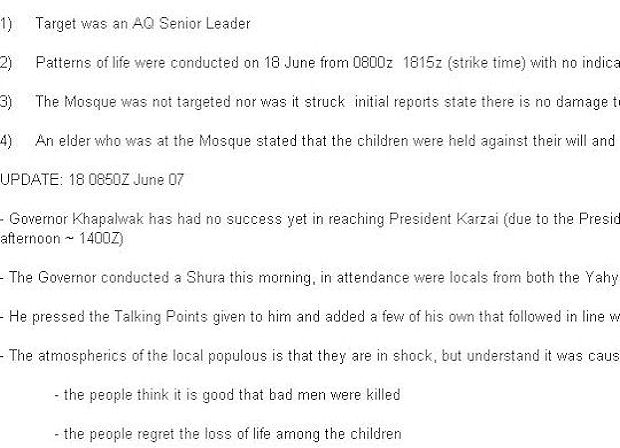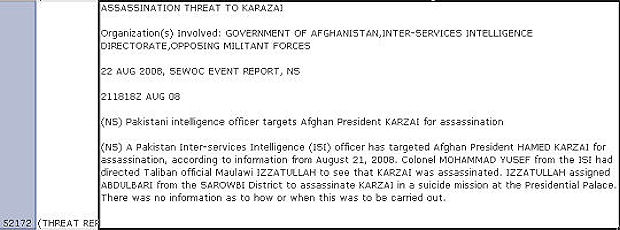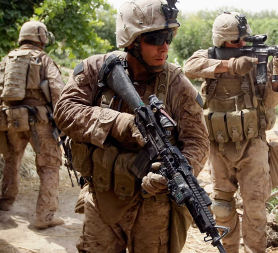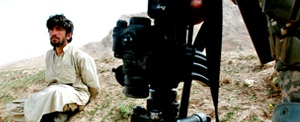Monday 26 July 2010
Channel 4 News has seen the classified documents but has been unable to independently verify their authenticity.War as we have never been allowed to see it: WikiLeaks editor Julian Assange speaks to Channel 4 News about his decision to publish 90,000 US military files - the biggest leak of its kind in history.
Secret Afghanistan files: revealed in massive data breach
The extraordinary leak made public by anti-secrecy website WikiLeaks has lifted the lid on more than 90,000 US military documents involving classified information direct from the battlefield in Afghanistan. It is the US army's secret war diary - 200,000 pages of it - written by soldiers on the frontline.
The files reveal previously classified information about civilian deaths, a mysterious "assassinations squad" named Task Force 373, an alleged Pakistani plot to kill President Karzai, evidence of suspected foreign support for the Taliban and countless daily incidents in which Nato troops are engaged by enemy forces.
The real story of this material is that it is war, it's one damn thing after another. It's the continuous small events, the continuous deaths of children, insurgents, allied forces, the millions of people.Julian Assange
WikiLeaks founder and editor Julian Assange has told a press conference in London the files could also contain details of "thousands" of potential war crimes.
He said: "It is up to a court to decide clearly whether something is in the end a crime. That said, on the face of it, there does appear to be evidence of war crimes in this material."
He said: "It is up to a court to decide clearly whether something is in the end a crime. That said, on the face of it, there does appear to be evidence of war crimes in this material."
Mr Assange said the files were not about one single horrific event but the bigger picture of the conflict, now in its ninth year.
He explained: "The real story of this material is that it is war, it's one damn thing after another.
"It's the continuous small events, the continuous deaths of children, insurgents, allied forces, the millions of people."
The data gives a graphical record of the war from 2004 until the end of 2009, detailing thousands of US military operations. The leaks contain "cables" filed by US units, often within a couple of hours of combat.
They contain logs of both civilian and military "kills" - pinpointing when and where a death happened. More than 20,000 deaths have been recorded overall.
He explained: "The real story of this material is that it is war, it's one damn thing after another.
"It's the continuous small events, the continuous deaths of children, insurgents, allied forces, the millions of people."
The data gives a graphical record of the war from 2004 until the end of 2009, detailing thousands of US military operations. The leaks contain "cables" filed by US units, often within a couple of hours of combat.
They contain logs of both civilian and military "kills" - pinpointing when and where a death happened. More than 20,000 deaths have been recorded overall.
Leaked files: death toll The classified reports contain detailed logs of fatalities - both military and civilian. Afghanistan expert and author Stephen Grey, who wrote Operation Snakebite, has analysed the data for Channel 4 News and calculated the number of deaths revealed in the report. Here is the breakdown: Enemy killed: 15,506 Civilians killed: 4,232 Afghan Army (ANA) killed: 3,819 Nato forces killed: 1,138
In an earlier interview with Channel 4 News, Mr Assange said he believed this is "the most comprehensive history of a war ever to be published - during the course of the war".
He explained: "We can see bungled operations, Special Forces go in to kill an alleged Taliban or al-Qaida, fire off missiles... kill seven children and in fact the target wasn't there.
"We can see how these lists are probably abused. There's no judicial process or review. We can see governors, local warlords, unhappy with a competitor and they nominate them to go onto these assassination lists."
He explained: "We can see bungled operations, Special Forces go in to kill an alleged Taliban or al-Qaida, fire off missiles... kill seven children and in fact the target wasn't there.
"We can see how these lists are probably abused. There's no judicial process or review. We can see governors, local warlords, unhappy with a competitor and they nominate them to go onto these assassination lists."
The most comprehensive history of a war ever to be published - during the course of the war.Julian Assange
The White House has issued a statement "condemning" the leak. The statement reads: "We strongly condemn the disclosure of classified information by individuals and organisations, [it] puts the lives of the US and partner service members at risk and threatens our national security.
"Wikileaks made no effort to contact the United States government about these documents, which may contain information that endangers the lives of Americans, our partners, and local populations who co-operate with us."
"Wikileaks made no effort to contact the United States government about these documents, which may contain information that endangers the lives of Americans, our partners, and local populations who co-operate with us."

'Underreporting' of civilian deaths by coalition forces
Some of the documents appear to indicate the "underreporting" of civilian casualties.
In 2008, an AC-130 "Spectre" gunship carried out a ground attack on the village of Azizabad in Herat Province. The target was a Taliban commander. The report at the time said that no civilians had died. It only refers to 30 insurgents killed in action.
In fact, according to a UN report, 90 civilians died - 60 of them children as well as 15 women.
Meanwhile in September 2006, troops taking part in Operation Medusa moved into a large area around Panjwayi, west of Kandahar, and a known Taliban stronghold.
A Nato report found that 31 civilians had died - 20 of them from the same extended family following an airstrike. The leaked documents record 181 deaths.
In 2008, an AC-130 "Spectre" gunship carried out a ground attack on the village of Azizabad in Herat Province. The target was a Taliban commander. The report at the time said that no civilians had died. It only refers to 30 insurgents killed in action.
In fact, according to a UN report, 90 civilians died - 60 of them children as well as 15 women.
Meanwhile in September 2006, troops taking part in Operation Medusa moved into a large area around Panjwayi, west of Kandahar, and a known Taliban stronghold.
A Nato report found that 31 civilians had died - 20 of them from the same extended family following an airstrike. The leaked documents record 181 deaths.
Top secret black-ops unit targeting Taliban and al Qaida leaders on 'capture/kill lists'
In June 2007 a special forces unit - Task Force 373 - attempted to kill or capture a senior al-Qaida commander. The leaked secret report shows that the operation left seven children dead. The documents also reveals that "TF 373" were using deadly high-mobility artillery rocket systems - known as "Himars" missiles.
Julian Assange told Channel 4 News: "There are many reports discussing the assassination lists that the US military have - hundreds, maybe thousands, of people are on these lists."
Afghanistan picture gallery: click here

(Revealed: a US military report details a failed attempt to kill a senior member of al-Qaida, which left seven children dead in June 2007)
Alleged plot by Pakistani intelligence to kill Afghan President Hamid Karzai
The files also contain material about Pakistan's ISI (Inter-Services Intelligence) operatives crossing over the border as well as firing by US troops from Afghanistan into Pakistan and covert droneflights.
There is a log on an alleged plot by ISI spies to assassinate Afghan President Hamid Karzai in August 2008. The log describes a "suicide mission" at the presidential palace, but concedes: "There was no information as to how or when this was to be carried out".
There is a log on an alleged plot by ISI spies to assassinate Afghan President Hamid Karzai in August 2008. The log describes a "suicide mission" at the presidential palace, but concedes: "There was no information as to how or when this was to be carried out".

Statement from the White House in full: "We strongly condemn the disclosure of classified information by individuals and organisations [which] put the lives of the US and partner service members at risk and threatens our national security. "Wikileaks made no effort to contact the United States government about these documents, which may contain information that endanger the lives of Americans, our partners, and local populations who cooperate with us." On Pakistan: "That said, the status quo is not acceptable, which is precisely why the United State has focused so much on this challenge. "Pakistan is moving in the right direction, but more must be done. The safe-havens for violent extremist groups within Pakistan continue to pose an intolerable threat to the United States, to Afghanistan, and to the Pakistani people who have suffered greatly from terrorism."
Who leaked the data?
Somewhere in the world at a US military base in the last six months, someone accessed a secret computer and started to copy the entire contents of a classified network.
They call it 'harm minimisation' but it is, of course, a form of censorship.
The information copied by that insider has now been placed on the internet by WikiLeaks.
Wilikeaks say they have cut out some references to sources of intelligence - to avoid them being killed by the Taliban. They call it "harm minimisation" but it is, of course, a form of censorship - a new departure for this group.
Parallels with the 'Pentagon Papers' The documents have drawn parallels with another major military leak, when in 1971 top secret papers about America's political and military involvement in Vietnam were brought to light in the New York Times. The study, officially titled United States-Vietnam Relations, 1945-1967, became known as the "Pentagon Papers" (see full text) and detailed the ultimately doomed involvement of the US in the conflict. Julian Assange, Wikileaks editor, told Channel 4 News this new data leak is even more significant. He said: "There doesn't seem to be an equivalent disclosure made during the course of the war when it might have some effect. the nearest equivalent is perhaps the Pentagon Papers released by Daniel Ellsberg in the 1970s which was about 10,000 papers - but that was already four years old when it was released."

Military acronyms and abbreviations: what they mean AAF - Anti Afghanistan forces (Taliban) AC-130 - Spectre gunship (heavily armed seek and destroy aircraft) ANA - Afghan National Army AWT - Advanced weapons team CJSOTF - Combined Joint Special Operations Task Force EKIA - Enemy killed in action EOM - End of message ETT - Engineer training team EWIA - Enemy wounded in action FF - Friendly forces HIMARS - High mobility artillery rocket system ISAF - International Security and Assistance Force JEL - Joint Effects List (low priority capture/kill list) JPEL - Joint Priority Effects List (Special Forces kill/capture list) KAF - Kandahar Air Field MEDEVAC - Medical evacuation NC - Non combatants (Civilians) NOFORM - Not for release to foreign nationals OBJ - Objective or target RPG - Rocket propelled grenade RPK - Soviet made light machine gun SAF - Small arms fire TB - Taliban TIC - Troops in contact WIA - Wounded in action Z - Zulu time. This refers to GMT which is standard for Nato military forces

Channel 4 News has charted the war from patrol in the northern mountains to current bitter fighting, writes Alex Thomson The mission since the invasion and occupation almost a decade ago now, has widened and spread beyond all recognition into de facto nation building from the new trunk road connecting the capital Kabul with Kandahar in the south - to giving Afghans the dubious benefits of voting and a bi-cameral western "democratic" model. Not bad ambition then, for a country built upon tribal fiat and warlord muscle, valley by valley, poppy field by poppy field, alongside hefty interference with money and weapons and know-how from Iran to the west, Pakistan has the east and the former Russian republics to the north: the Great Game continues alive and well. So down the near decade of war now, Channel 4 News has charted that stark war from the horse-mounted patrols of the British armies in the northern mountains, to the current bitter fighting across the poppy and wheat fields of southern Helmand Province. Afghanistan: taking on the Taliban - special report
No comments:
Post a Comment